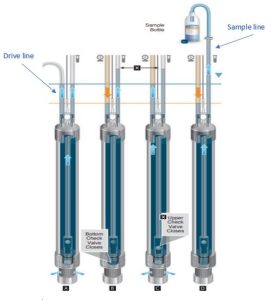 Retrieving groundwater samples during mining processes is a tricky, but necessary, task. The harsh and isolated conditions can make these processes particularly difficult.
Retrieving groundwater samples during mining processes is a tricky, but necessary, task. The harsh and isolated conditions can make these processes particularly difficult.
Fortunately, Solinst Double Valve Pumps offer a practical solution for groundwater sample extraction. Double Valve Pumps work by using air to pump out liquids from the ground. They provide high quality, consistent samples, and excellent VOC (Volatile Organic Compound) samples. They are suitable for low and regular flow sampling and have thousands of applications.
Here are some of the benefits the Solinst Double-Valve Pumps provide. The pumps require no bladder, which allows for higher flow rates, and easy decontamination. All components are easily accessible and replaceable without the need for specialised tools. They can be cleaned with mild detergent or non-phosphate soap.
The pump can withstand the harsh conditions commonly found in mining, including operation in sediment-laden water and under dry pumping conditions.
All components of this technology are easily transportable from site to site with the DVP, thanks to range of fitting options.
The low flow sampling feature reduces purge volumes and time taken to obtain a sample. Thus, the need for repeat sampling is minimised, reducing the time needed for each sampling round.
Another notable advantage of the Solinst Double Valve Pumps is the availability of a dedicated version. This version streamlines the sampling process, by enabling simultaneous purging of all zones. This product saves valuable time and effort, as equipment is not lowered into the borehole, reducing purge volumes. Consequently, this not only results in significant cost savings, but also reduces risk of cross-contamination. Given the challenging conditions often encountered in mining environments, this feature makes the Solinst Double Valve Pump an invaluable asset.
Groundwater sampling method using the Solinst Double-Valve Pump:
 Stage A: The pump is placed in the well. Hydrostatic pressure then fills the pump body, Drive Line, and Sample Line to the static water level.
Stage A: The pump is placed in the well. Hydrostatic pressure then fills the pump body, Drive Line, and Sample Line to the static water level.
Stage B: Water circulates from the Drive Line, through the pump to the Sample Line, with the Bottom Check Valve preventing water return.
Stage C: The system is vented, allowing water to fill the Drive Line back to static level.
Stage D: Pressure is reapplied to the Drive Line, raising water levels in the Sample Line closer to the surface. This pressure and vent cycle is repeated multiple times until water in the Sample Line is expelled at the surface in a gentle pulsating flow.
Further information:
Pumps are available in stainless steel 5/8″ diameter, and 1.66″ diameter. Portable or dedicated versions are available. They can be fitted with packers to control groundwater flow and limit purge requirements. DVPs are easily disassembled for decontamination in minutes, without any tools.
- Excellent performance and reliability
- Selection of sizes (5/8” and 1.66” diameter)
- Well caps available for dedicated applications
- Long term monitoring
- If operated with precision, air will never contact the sample water, producing comparably representative samples
For more details on this product, call HydroTerra today on (03) 8683 0091. Or click below for further information.
Solinst Double Valve Pumps





